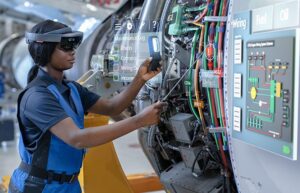Definition
Augmented reality (AR) is defined as a technology that combines computer-generated images on a screen with the real object or scene that you could look at (Oxford University Press, n.d.). It is an enhanced version of the real physical world that is achieved by utilising the digital visual elements, sound or other sensory stimuli.
It is a popular trend among companies to incorporate AR in mobile computing and business applications. Amid the rise of data collection and analysis, one of AR’s goals is to showcase specific features of the physical world, enhance understanding of said features and derive smart and accessible insights that can be applied to real-world applications. For instance, AR is used to showcase a room filled with 3D furniture, a street with a virtual track or a colouring book with animated cartoons (Zappy Production, 2022).
Some of the benefits are collecting data and gaining new customers, showing a brand-new product virtually from a physical catalogue or even for entertaining customers through AR (Zappy Production, 2022).
Technology and Components of Augmented Reality
Augmented Reality devices comprise of high-speed processors, input devices such as cameras or web cameras (webcams), various types of sensors and display units such as smartphones, handheld devices, smart glasses or head-mounted displays).
In addition, the AR function relies heavily on the software. A 3D software is needed to generate virtual pictures, which will overlap with the image of the real world. Some examples are AutoCad3D, Masterpiece Studio Pro, Cinema 4D, Amazon Sumerian, Google Tilt Brush and StudioMax.
Besides hardware and software, remote servers or cloud-based servers are also important to provide the database for the scanned virtual pictures. When the AR programme makes a request, the remote server obtains the stored virtual pictures and information from the central server’s unified database and passes it over to the requesting application to be displayed.
According to Chai, O’Sullivan, Gowen, Rooney, & Xu, 2022, AR technology in Food and Beverage (F&B) industry is typically applied in the following areas: dietary assessment, food nutrition and traceability, food sensory science, retail food chain applications, food education and learning, and precision farming.
In 2017, Starbucks Reserve Roastery in Shanghai became the first Starbucks in the world to utilise AR to improve customer experience in its premises. There, a two-storey copper vessel decorated with about 3,000 hand-carved traditional Chinese stamps were used as AR markers (Kats, 2017). (AR marker is an image or object that can be recognised by an AR-enabled mobile app and is used to activate the augmented reality features). Once a customer scans one of the stamps using their phone, he will be able to peer inside the cask through the Starbucks’s AR Application. He can then watch an animated version of newly roasted beans dropping into the cask and see how they travel through copper pipes to the coffee bars. In addition, the customer is able to learn about the process of creating a cup of coffee. It also serves as a digital tour guide to the customer in the roastery. A customer can collect virtual badges and once all of them have been earned, he can unlock a customised roastery social media filter to share.
Besides enriching the customer’s experience, the AR technology is utilised for online ordering. The customer can order his food and drinks from anywhere in the 30,000-square-foot building (Kats, 2017). He can view the menu in the app or point his phone at an icon hanging from the ceiling to view the menu using the AR technology to place his order. Once he has paid digitally, the app will notify him to collect his food and drinks.

Boeing is providing AR glasses to its technicians to assist them during the conception phase and for routine maintenance of aircrafts. However, it is too early to assess the effect of AR devices on the assembly line efficiency and maintenance quality. With the increasingly affordable cost of AR technologies, these trials will likely continue to be further developed for aerospace industry.
AR has significant applications in training to create low-risk effective training missions, especially for pilots. The high potential of creating safe training environments for new pilots will propel higher utilisation of AR in the industry. Virtual Reality has a drawback whereby the environment is completely simulated and unnatural, whilst AR can provide a real environment training platforms where only the threats and obstacles are simulated.
For example, TAE Aerospace, an Australian engine maintenance, repair and overhaul (MRO) company, developed Fountx, a wearable AR device that allows remote experts to diagnose and assist on-field technicians in real-time from anywhere of the world (Raval, 2021). Using this technology, the company could save the experts’ travel costs, and the time taken to complete repair works is reduced tremendously. Engineers can also use AR to investigate and address technical issues such as wiring issues and design flaws. Safran Group of Companies has developed a new AR technique to improve aircraft wire repairs. This revolutionary approach is currently available to airlines.
Besides MRO, AR is used to enhance the creation of prototypes. Manufacturing new equipment using AR could speed up the process and could save time for the development of new products. Currently, NASA is using AR technology developed by Lockheed Martin to fasten the construction of the Orion spacecraft (Raval, 2021).

Bibliography
Chai, J. J., O’Sullivan, C., Gowen, A. A., Rooney, B., & Xu, J.-L. (2022). Augmented/mixed reality technologies for food: A review. Trends in Food Science & Technology, 182-194. Retrieved from Augmented/mixed reality technologies for food: A review
Hayes, A. (2022, October 29). Augmented Reality (AR) Defined, with Examples and Uses. Retrieved from Investopedia: https://www.investopedia.com/terms/a/augmented-reality.asp
Kats, R. (2017, December 3). Marketing Dive. Retrieved from Starbucks brings coffee to life via interactive augmented reality app : https://www.marketingdive.com/ex/mobilemarketer/cms/news/software-technology/11537.html
Ng, C., & Ramasamy, C. (2018). Augmented Reality Marketing in Malaysia—Future Scenarios. Socia Sciences MDPI, 1-15.
Oxford University Press. (n.d.). Oxford’s Learner’s Dictionaries. Retrieved from Augmented Reality: https://www.oxfordlearnersdictionaries.com/definition/english/augmented-reality?q=augmented+reality
Raval, C. (2021, September 30). Augmented Reality Trends in Aerospace and Defense. Retrieved from eInfochips: https://www.einfochips.com/blog/augmented-reality-trends-in-aerospace-and-defense/
Zappy Production. (2022, November 22). Augmented Reality. Retrieved from Zappy Production: https://zappyproduction.com/augmented-reality-company-in-malaysia/
